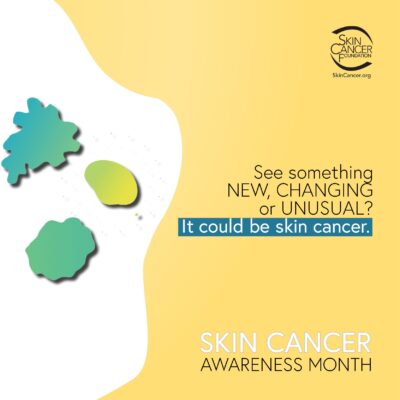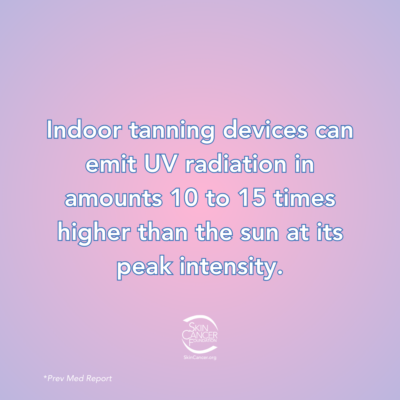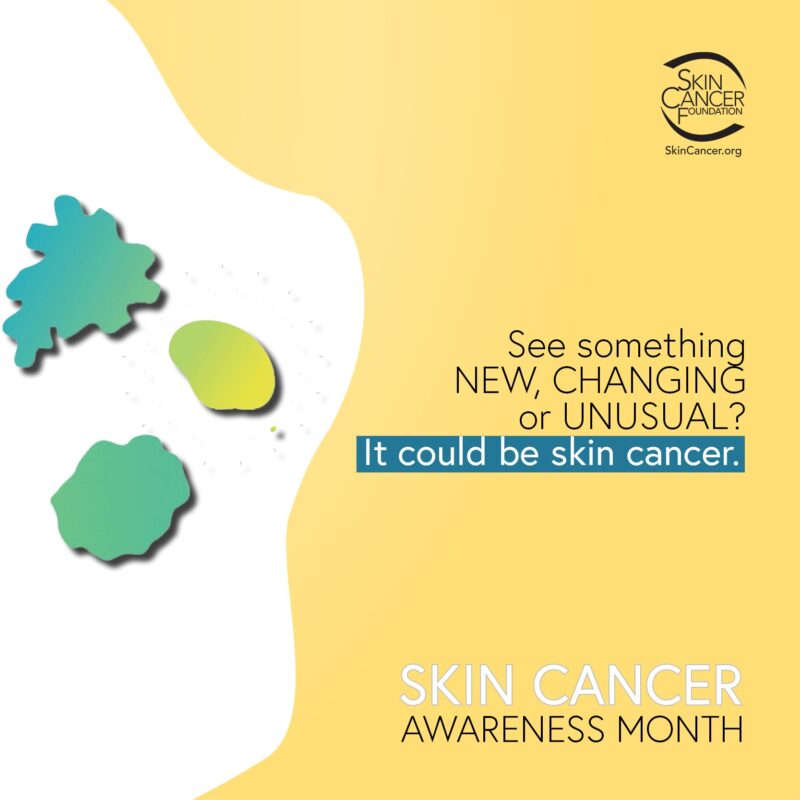May is Melanoma and Skin Cancer Awareness Month.
Skin cancer can happen to anyone, at any time, on any area of the body. It is the most common type of cancer and one of the most preventable.
Skin cancer can appear in different shapes, sizes and colours, and may not look the same for each individual. It is so important to self check monthly and see a dermatologist for any new, quickly changing, or questionable spots.
What puts us at risk of skin cancer?
- Tanning Beds
- Sunburns
- Unprotected Exposure to UVA & UVB rays
- Skin Type
- Red Hair
- Genetics
- Atypical Moles
There is no such thing as a safe tan, except for self-tanning lotions. Tanned skin is a sign of DNA damage. When the skin is exposed to UV from the sun or tanning beds, it tries to protect itself from DNA injury by producing melanin, resulting in a tan or sunburn. The amount of melanin you have is based on your genetics. So some people will easily tan, while others just burn. Both a tan, and a sunburn, are signs of cellular damage.
The visible damage of a tan or sunburn can also lead to fine lines and wrinkles, brown spots, and dull, tired looking skin.
Going to tanning beds is just as, if not more, harmful than getting a tan from the sun. Tanning beds typically only emit UVA rays, which are the damaging and aging rays and will increase the risk of melanoma. Tanning beds are also not a good source of vitamin D, as vitamin D is produced by the UVB rays.
Getting that base tan before a holiday is just exposing you to more UV damage and you are still at risk of a sunburn. Any sunburn you do get, increases your risk of skin cancer. So, stick to a healthy glow from self-tanning lotions.
Protection from UV Rays and Skin Cancer:
Be sure to protect your skin when enjoying the outdoors, 365 days a year.
Wear your broad spectrum SPF daily (SPF 30+) and be sure to reapply regularly when you are spending longer periods of time outside. Don’t forget your sun protective clothing (UPF rated) and wide brimmed hat. Avoid the direct sun exposure by seeking shade and staying indoors during peak sun hours.
SPF is the Sun Protection Factor and a measurement of how well you will be protected from getting a sunburn. However, a higher SPF doesn’t always mean more protection.
Rough estimate of UVB protection with your SPF:
- SPF 15: blocks 93% of UVB rays
- SPF 30: blocks 97% of UVB rays
- SPF 50: blocks 98% of UVB rays
- SPF 100: blocks 99% of UVB rays
A higher SPF can sometimes lead to a false sense of security or make you think you can be out in the sun longer without protection. So be sure to use at least SPF 30 and reapply every 2 hours. And don’t forget your sunscreen even while inside as UVA rays can be passed through windows.
Types of Skin Cancer:
Actinic Keratosis: A Common Precancer
AKs appear as small, dry, scaly or crusty patches of skin. They may be red, pink, brown, or a combination of colours and are sometimes raised. AKs will appear on sun exposed skin and are typically benign but it is still good practice to have them regularly checked by a doctor.
Basal Cell Carcinoma: The Most Common Skin Cancer
BCC is the most common form of skin cancer and the most frequently occurring form of all cancers. BCCs can look like open sores, red patches, pink growths, shiny bumps/scars/growths with slightly elevated rolled edges. These spots may ooze, crust or bleed and are commonly found on sun-exposed areas of the body.
Squamous Cell Carcinoma: The Second Most Common Skin Cancer
SCC is the second most common form of skin cancer and when caught early can be curable. SCCs can appear as scaly red patches, open sores, rough, thickened, or wart-like, or raised growths with a central depression. Some SCCs may crust over, itch or bleed and will most commonly be found in sun-exposed areas of the body.
Melanoma: A Dangerous Skin Cancer
Malignant Melanoma is a serious form of skin cancer that begins in our melanocytes. This cancer is less common and more dangerous with the ability to spread rapidly to other organs if not treated early. When detected and treated early, melanoma is usually curable.
It’s difficult to provide a set list of warning signs as melanoma can present in many different shapes, sizes, and colours.
Really, anyone who has skin is at risk of skincare. So protect your skin, do your monthly self-checks and see your dermatologist for yearly full body exams!



